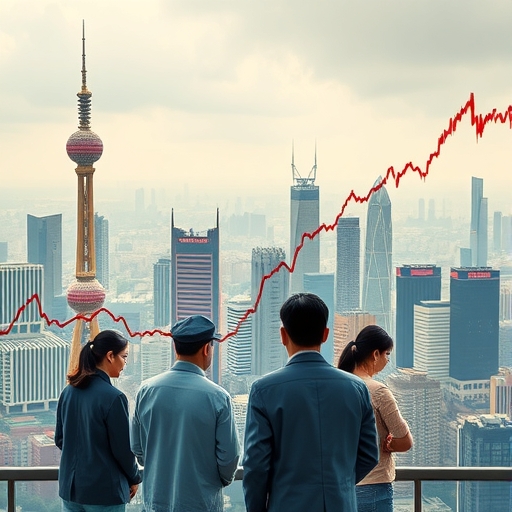Navigating the Tempest: An Introduction to China’s Volatile Stock Market Landscape
Welcome, fellow investors, to a deep dive into one of the most dynamic and, at times, perplexing financial arenas in the world: the Chinese stock market. When we consider global finance, China stands as an undeniable behemoth, its economic ripples often transforming into waves that crash upon distant shores. Yet, beneath its towering influence lies a market characterized by dramatic peaks, precipitous falls, and a unique interplay between state control and free-market forces. Understanding these dynamics is not merely an academic exercise; it is crucial for anyone looking to navigate the interconnected global economy, whether you are a seasoned trader or just beginning your investment journey.
Over the past decade, we have witnessed significant episodes of market turmoil, most notably the Chinese stock market crash of 2015, which sent shockwaves across continents. These events are not isolated incidents but rather complex tapestries woven from economic data, government policy, investor sentiment, and geopolitical tensions. As we journey through these historical turning points, we will dissect the catalysts, analyze Beijing’s often unprecedented responses, and explore the far-reaching global impact. Our aim is to equip you with the knowledge to comprehend these intricate systems, drawing lessons that are invaluable for managing your own investments and identifying opportunities amidst volatility.
- The Chinese stock market is influenced by several factors, including government policies and global economic trends.
- Investor sentiment plays a crucial role in market fluctuations, leading to rapid changes in stock valuations.
- Understanding both historical crash events and government interventions provides insights into future market behaviors.

The Ground Zero: Unpacking the 2015 Chinese Stock Market Crash
Imagine a market that had soared to dizzying heights, fueled by exuberant retail investors and readily available credit. This was the scene preceding the Chinese stock market crash of 2015. After a meteoric rise that saw stocks double in just a year, the bubble began to deflate with alarming speed. We saw staggering drops, such as the 8.5% single-day decline on August 24, 2015, which swiftly evaporated all the gains accumulated over the preceding months. What initiated this precipitous descent, and why did it unfold with such ferocity?
Several critical factors converged to trigger this financial wipeout. Firstly, the market had become dangerously overheated, with valuations stretching far beyond fundamental economic realities. Many individual investors, often less experienced, piled into stocks using borrowed money, leading to dangerously high levels of leverage. When prices began to falter, these highly leveraged positions quickly triggered margin calls, forcing investors to sell more shares to cover losses, thereby accelerating the downward spiral. Secondly, and perhaps more significantly, was the unexpected devaluation of the Chinese yuan. This move, intended to boost exports, was interpreted by global markets as a signal of deeper economic weakness, intensifying fears about China’s growth trajectory and leading to a rapid erosion of investor confidence.

The Yuan’s Ripple: Currency Devaluation and Global Market Jitters
The surprise devaluation of the Chinese yuan in August 2015 served as a potent catalyst, amplifying the market’s existing vulnerabilities and sending an unequivocal signal of potential trouble to the world. A weaker yuan indicated that Beijing was concerned about its export-driven economy, especially in light of disappointing trade data that year. We observed China’s exports declining and imports falling even more sharply, painting a bleak picture of both external demand and internal consumption. This sudden currency adjustment, while a tool of economic policy, inadvertently became a major trigger for the Chinese stock market crash, fueling widespread speculation about the true health of the nation’s economy.
The immediate consequence was a significant uptick in global market jitters. When the world’s second-largest economy signals weakness through currency depreciation, other markets naturally brace for impact. We saw a swift reaction in global bond markets, with a flight to safety as capital sought refuge in perceived stable assets like U.S. and German government bonds. This phenomenon is a classic sign of market participants anticipating an economic slowdown or broader economic crisis. For you, the investor, recognizing these macroeconomic signals—currency movements, trade data, and bond market shifts—is paramount, as they often foreshadow significant volatility across all asset classes.
Beijing’s Firm Hand: The Anatomy of Market Bailouts and Policy Directives
In the face of unprecedented market turmoil, Beijing’s response was swift and monumental, underscoring the state’s deep involvement in its financial markets. The government undertook massive market bailout efforts, spending at least $236 billion on market stabilization in 2015 alone. This was a clear demonstration of resolve to prevent a systemic collapse and restore investor confidence, even if it meant directly intervening in market mechanisms. But what forms did these interventions take, and what was their rationale?
The measures were multifaceted. The China Securities Regulatory Commission (CSRC) suspended Initial Public Offerings (IPOs) to reduce supply pressure and calm panic. State-backed entities, including the “national team,” directly purchased stocks to prop up prices, effectively becoming the market’s largest buyer. Additionally, restrictions were placed on short-selling, and major shareholders were even prohibited from selling shares for a period. Chinese officials, including the vice finance minister Zhu Guangyao, defended these interventions as “necessary” to prevent “systemic risks” and ensure financial stability. For us, observing these actions provides crucial insights into how a state-controlled economy attempts to manage a free-floating financial system, often blurring the lines between policy and market forces.
Beyond the Billions: Regulatory Crackdowns and the Pursuit of Stability
Beyond the direct financial injections, Beijing’s response to the market crisis extended into a forceful regulatory crackdown. The aim was to root out perceived manipulation and malpractice that contributed to the volatility. This led to a wave of investigations and arrests, with approximately 200 individuals linked to market activities detained. The government sought to demonstrate accountability and restore faith in the fairness of the market, a critical step for long-term stability.
However, Beijing’s intervention wasn’t always a direct, unlimited injection of funds. There were instances where the People’s Bank of China (PBOC) deliberately withheld further rate cuts or direct buying, perhaps to test the market’s limits or to manage the yuan’s stability, balancing multiple policy objectives. This calibrated approach highlights the tightrope walk Beijing performs: intervening decisively when needed, but also being mindful of creating moral hazard or distorting market signals too severely. As investors, we must understand that while government support can cushion falls, it cannot perpetually defy market gravity or erase underlying economic issues. The absence of continuous stimulus can lead to rapid sell-offs, particularly for investors accustomed to official assurances of support.
The Global Echo Chamber: How China’s Quakes Rattle International Finance
The tremors from the Chinese stock market crash did not remain confined within China’s borders; they propagated rapidly through the interconnected global financial system. The sheer scale of the downturn in China spooked international investors, triggering a significant and immediate capital flight from perceived risk assets worldwide. We witnessed a domino effect: U.S. futures hit their limit down, and the Dow Jones Industrial Average plunged by over 5% on a single day, reflecting the immediate contagion from Asia. This widespread investor panic underscored China’s systemic importance to the global economy.
Capital, ever seeking safety in uncertain times, flowed swiftly into traditional safe havens. U.S. and German government bonds rallied strongly, their yields falling as demand surged. This shift also triggered a significant “carry trade unwind,” a complex financial phenomenon we will explore further. Currencies were also affected, with the U.S. dollar weakening against the euro and yen as global investors diversified their exposure away from higher-yielding, riskier assets. The International Monetary Fund (IMF) openly cautioned global markets to prepare for a China slowdown, a stark warning that highlighted the potential worldwide economic impact. For you, this serves as a powerful reminder that in our globalized world, a significant market event in one major economy can swiftly cascade, affecting your diversified portfolio in ways you might not immediately foresee.
Understanding the “Carry Trade Unwind” and Its Worldwide Repercussions
One of the more sophisticated yet impactful consequences of China’s market instability was the phenomenon known as the “carry trade unwind.” To truly grasp its significance, let’s briefly define it. A “carry trade” involves borrowing money in a currency with a low interest rate (like the Japanese yen or Swiss franc) and investing it in assets denominated in a currency with a higher interest rate (often emerging market currencies or riskier assets). The goal is to profit from the interest rate differential. When market volatility surges, or confidence in riskier assets wanes, investors rush to exit these trades. This means selling the higher-yielding assets and buying back the low-yielding currency to repay the loan, leading to rapid and often dramatic currency movements.
During the Chinese stock market crash and subsequent global financial jitters, the unwind of these carry trades contributed significantly to the capital flight we discussed. As investors unwound their positions, they pulled funds out of riskier emerging markets and even developed market equities, leading to broader market plunges. This put immense pressure on currencies like the Australian dollar and various emerging market currencies that had benefited from the carry trade. Simultaneously, the low-yielding currencies, previously used as funding vehicles, experienced significant appreciation as they were bought back. This complex interplay demonstrates how financial engineering, seemingly disconnected from the immediate crisis in China, can amplify its global repercussions. Understanding such mechanisms is key to appreciating the interconnectedness of modern finance, and as you consider diversifying your own investment strategies, especially across currencies and various CFD products, platforms offering flexible trading options become crucial. If you’re exploring such opportunities, Moneta Markets is an Australian-based platform that provides over 1000 financial instruments, suitable for both new and experienced traders, making it a valuable option for engaging with global markets.
Investor Psychology and the Perils of Leverage in Volatile Markets
While economic data and policy decisions form the macroeconomic backdrop, the actual market movements are ultimately driven by human behavior. The Chinese stock market crash of 2015 provides a stark lesson in investor psychology, particularly concerning the allure and dangers of leverage. Many retail investors, often described as “uneducated” speculators in the context of advanced financial mechanics, had jumped into the market with borrowed funds, emboldened by a seemingly unending rally and perhaps implicit promises of government support.
When the market turned, these highly leveraged positions quickly became unsustainable. We saw widespread margin calls, forcing investors to liquidate their holdings at a loss to meet their debt obligations. This created a vicious cycle: forced selling pushed prices down further, triggering more margin calls, and so on. The human cost was immense; reports emerged of individual investors losing their life savings. Even prominent figures were not immune, with Asia’s richest man, Wang Jianlin, reportedly losing a staggering $13 billion during the crash. This highlights a fundamental truth: while leverage can magnify gains, it equally magnifies losses, and relying solely on government intervention to bail out individual speculative bets is a perilous strategy. As investors, cultivating disciplined risk management and understanding the true implications of leverage are far more crucial than chasing fleeting market bubbles.
The Shadow of Geopolitics: Trade Wars and Future Market Vulnerabilities
Fast forward to a hypothetical 2025 scenario, and we see how the specter of geopolitical tensions continues to cast a long shadow over China’s financial markets. Escalating global trade tensions and the imposition of significant U.S. tariffs—some exceeding 50% on Chinese goods—are highlighted as potent drivers for potential future market plunges. These tariffs directly impact China’s export-driven economy and threaten the earnings of its companies. China’s retaliatory tariffs further intensify the trade spat, creating a climate of uncertainty that can quickly erode investor confidence.
Beyond tariffs, discussions around “de-dollarization” and the restructuring of global supply chains also play a significant role. As the U.S. forges new trade deals with countries like Japan, South Korea, the EU, and Vietnam, China’s export landscape faces new hurdles. However, the market can also find reasons for optimism amidst these challenges. For instance, the hypothetical resumption of chip sales by Nvidia to China (with export license assurances) positively impacted Hong Kong stocks in 2025, demonstrating how specific policy shifts or corporate developments can provide temporary relief from broader geopolitical pressures. This ongoing interplay between politics, policy, and market dynamics means that understanding geopolitical risks is now an integral part of market analysis for any investor.
Beyond the Downturn: Signals of Resilience and the Path to Growth
Despite the dramatic crashes and persistent vulnerabilities, it would be incomplete to portray China’s markets as a perpetual state of crisis. Indeed, even within the hypothetical 2025 data, we observe compelling signals of resilience and underlying economic strength. We see positive economic indicators such as a robust 5.2% GDP growth and a healthy 5.8% export growth, which have, at times, contributed to surges in Hong Kong stocks and a more optimistic outlook for Chinese earnings.
Furthermore, the market has shown signs of evolving maturity, with record-breaking ETF issuance indicating growing investor interest and a shift towards more diversified investment vehicles. This underlying demand, coupled with anticipated policy support from Beijing, including potential Politburo meetings to discuss future economic strategy, suggests that the authorities remain committed to fostering stability and growth. Even amidst the panic, some analysts, such as those at Goldman Sachs, maintained a more nuanced view, categorizing China’s issues as “problems” rather than a full-blown “crisis,” acknowledging the deep structural resilience of its economy. For you, this means looking beyond the headlines and recognizing that even in highly volatile markets, opportunities and signs of recovery can emerge if you are equipped with the right analytical framework.
Your Roadmap to Resilience: Lessons from China’s Market for Every Investor
The journey through China’s stock market volatility offers invaluable lessons for every investor, regardless of your geographical focus. First and foremost, it underscores the paramount importance of risk management. The perils of excessive leverage, especially for “uneducated” speculators, were starkly evident. Never bet more than you can afford to lose, and understand that government intervention, while powerful, is not a guarantee against individual losses. Diversification is another critical takeaway. Relying heavily on a single market, especially one as prone to rapid shifts as China’s, exposes you to concentrated risk. Spreading your investments across different asset classes, geographies, and even currencies can significantly buffer the impact of localized downturns.
Furthermore, this analysis highlights the profound impact of policy on markets. Understanding the nuances of a nation’s fiscal and monetary policy, central bank actions (like the PBOC’s), and regulatory crackdowns is not just for economists; it’s essential for investors. Finally, recognizing the interplay between economic fundamentals, market sentiment, and geopolitical forces is crucial. No market exists in a vacuum. As you navigate these complex dynamics, the right trading platform can significantly enhance your ability to implement diversified strategies. For instance, in seeking a broker with robust regulatory oversight and global reach, Moneta Markets holds multiple international licenses, including FSCA, ASIC, and FSA, offering features like segregated client funds, free VPS, and 24/7 multilingual customer support, making it a reliable choice for traders worldwide.

Charting the Future: China’s Enduring Influence on the Global Economic Tapestry
As we conclude our exploration of China’s volatile stock market, one undeniable truth emerges: its stability, or lack thereof, holds profound implications for the entire global economy. The recurring cycles of rapid growth, speculative bubbles, sudden crashes, and aggressive government intervention are not merely historical footnotes; they are ongoing lessons in the unique characteristics of China’s financial system.
For you, the investor, the key takeaway is continuous learning and adaptability. The world is dynamic, and financial markets, especially those as influential as China’s, will continue to present both formidable challenges and compelling opportunities. By understanding the forces at play—from yuan devaluations and trade wars to state-backed bailouts and evolving investor behavior—you are better equipped to make informed decisions. China’s journey from a developing economy to a global powerhouse has been marked by remarkable transformation and occasional turbulence. How Beijing manages its economic slowdown, addresses deflationary pressures, and navigates escalating trade tensions will undeniably shape the future trajectory of global finance. Our collective ability to understand these intricate connections will determine our individual and collective financial resilience in the years to come. Remember, the market is a teacher, and every downturn, including the significant Chinese stock market crash, presents valuable lessons for those willing to learn.
| Key Events | Date | Impact |
|---|---|---|
| Chinese Stock Market Crash | August 24, 2015 | 8.5% decline in one day |
| Yuan Devaluation | August 2015 | Signal of economic weakness |
| Market Bailout by Government | 2015 | $236 billion spent on stabilization |
chinese stock market crashFAQ
Q:What is the Chinese stock market crash of 2015?
A:The crash refers to a significant decline in stock prices that occurred in mid-2015, marked by an 8.5% drop on August 24, 2015.
Q:What caused the crash?
A:Key factors included an overheated market, high levels of leverage among retail investors, and the sudden devaluation of the Chinese yuan.
Q:What were the global implications of the crash?
A:The crash led to increased volatility in global markets, capital flight from risk assets, and a rush to safe haven investments.

留言